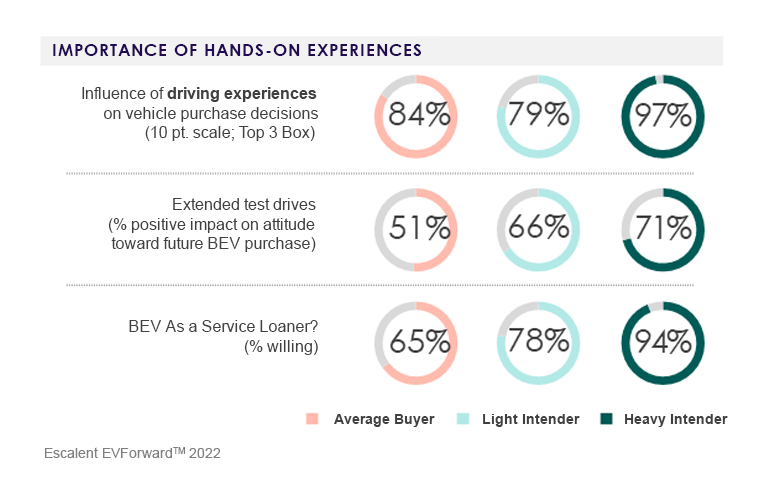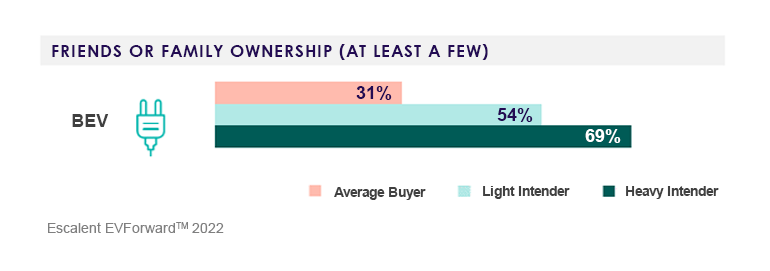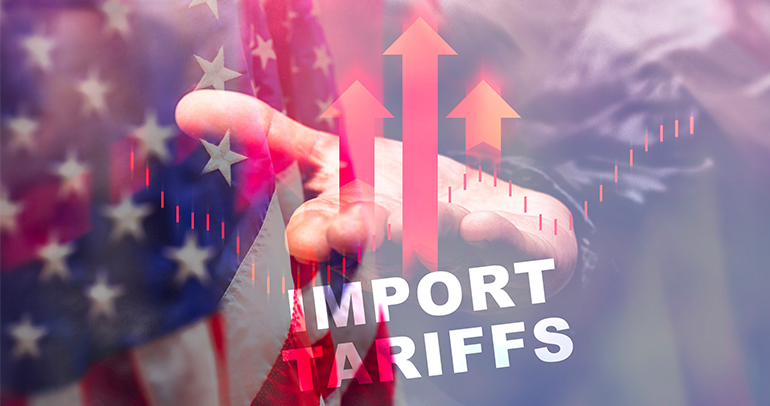
Each year, we recruit 10,000+ new-car buyers to participate in our EVForwardTM research program on the next generation of electric vehicle (EV) buyers, which includes battery electric vehicles (BEV) and plug-in hybrid electric vehicles. Using more than 600 data points, including factors such as past behavior, life values, and the vehicle habits of their circle of influence, we categorize respondents into four groups based on their likelihood to shop for an EV: EV Owners, EV Intenders, EV Open and EV Resistant.
EV Intenders are 15 times more likely to shop for a BEV than the average new-car buyer, making them low-hanging fruit for dealers and automakers. However, within that group, there are broad differences in motivation and intention, according to our new Heavy EV Intender DeepDive report. In this report, we broke the EV Intender group into “Heavy” and “Light” EV Intender subgroups based on the distribution of our EVForwardTM score, a proprietary scoring algorithm that predicts each respondent’s likelihood to shop for a BEV in the next five years.
How BEV Exposure Impacts Heavy and Light EV Intenders
Examining BEV exposure uncovers differences between the two groups and highlights the importance of consumer exposure to BEVs.

Almost 70% of Heavy EV Intenders have family and friends with a BEV. Approximately 29% have driven or ridden in one, and they give the experience high marks, with more than 90% saying it felt better than driving a gas or diesel vehicle.
As a result of their exposure, Heavy EV Intenders also have a better understanding of the costs of owning a BEV—and are prepared to pay them. They recognize the need to invest in Level 2 home charging, and 89% say they are willing to pay to install it. When asked to estimate the costs, they have a far more realistic picture of the price tag.
In contrast, only 14% of Light EV Intenders report having some experience in a BEV. They also underestimate the installation cost by several hundred dollars, and only 65% say they are willing to make the investment.
Automakers and dealers can address these gaps by:
- Increasing communication and providing more informational resources around the realities, costs and advantages of owning a BEV.
- Offering opportunities to get consumers into the driving seat.

Both EV Intender groups agree that hands-on experiences, such as test drives, matter. Almost 100% of Heavy EV Intenders and 79% of Light EV Intenders said that riding or driving experience influenced their decision to purchase their current vehicle, and Heavy EV Intenders have a much higher likelihood to say that they have driven or know BEV powertrains well.
Because Light EV Intenders lack an in-depth understanding of the BEV ecosystem, they may be particularly influenced by traditional dealership experiences that provide personalized BEV education and by the brand recognition that BEVs from established automakers can offer.
BEV Exposure Generates Excitement
The exposure to BEVs, both from friends and family and through driving the powertrain, translates to excitement and a high likelihood Heavy EV Intenders will purchase a BEV for their next vehicle.
Heavy EV Intenders hold BEVs in high esteem, see them as overwhelmingly practical, and are 20 times more likely to shop for a BEV than the average consumer. While Heavy EV Intenders still have concerns about range and charging availability, citing these as primary barriers to purchase, they have already familiarized themselves with the powertrain and the various ways to accommodate their charging needs. When asked how likely they are to purchase a vehicle with a battery electric powertrain, Heavy EV Intenders score BEVs at 91 out of 100.
Light EV Intenders, on the other hand, score lower across all BEV metrics. They demonstrate less understanding of BEVs and have more concerns about the practicalities of owning one. Additionally, they are less likely to have previous exposure to BEVs and, therefore, less likely to be convinced of the benefits. Giving BEVs a 56 out of 100 when asked how likely they are to purchase one, Light EV Intenders demonstrate significant interest in other drivetrains, including internal combustion engines. This suggests Light EV Intenders are likely to consider both gas vehicles and BEVs during the shopping process.
Factors That Motivate BEV Consideration and Purchase
Light and Heavy EV Intenders look for different things in a vehicle, too. Threats to the environment loom large in Heavy EV Intenders’ minds: 89% said they considered climate change a significant problem and see owning a BEV as a way to make a difference.
Heavy EV Intenders are also 2.5 times more likely to be “innovators”—consumers who like to be among the first to try new products, based on the diffusion of innovation theory. Buyer motivations reflect this, with 87% of Heavy EV Intenders saying they love the new technology that is becoming available.
While Heavy EV Intenders are acutely climate-aware and often already sure that a BEV is the right choice for them, Light EV Intenders are not as motivated by environmental concerns even though 78% say they are a major problem. Relative to Heavy EV Intenders, Light EV Intenders are more concerned with battery life and replacement costs, charging inconvenience and reliability.
As a result, the messaging needs of both groups vary. Heavy EV Intenders are the low-hanging fruit likely to be driven by emotional conversations highlighting the environmental benefits of driving a BEV and appealing to consumers’ self-actualization desires to be seen by peers as future-looking and pioneering with cutting-edge technology. Light EV Intenders, meanwhile, will be a bit harder to reach, requiring reassurances around practical issues such as quietness, reliability and battery life.
Smoothing the Path to Purchase for EV Intenders
Rather than relying on Light EV Intenders to do their own research, automakers and dealers can play a crucial role in boosting enthusiasm and addressing barriers to purchase by investing in efforts to educate prospective buyers about the value, reliability and efficiency of BEVs. Ride-and-drive events, test drives and BEV service loaners all offer additional opportunities to close the exposure gap between Light and Heavy EV Intenders.
While Heavy EV Intenders are typically comfortable forging the way with new technology, the next wave of BEV buyers will demonstrate more caution. For the more BEV-wary consumers, facilitating driving experiences and enhancing messaging around the personal benefits and emotional aspirations of BEV ownership may be the tipping point on the path to purchase.
In our report, we cover a much wider breadth of findings on Heavy and Light EV Intenders, including insights into shopping behaviors, lifestyles, EV brand recognition, retail approaches, charging attitudes, and what EV players can do to better reach and impact this audience. If you would like to learn more about our EVForward study of future EV buyers, the differences among EV Intenders, or how we can help you refine your electric vehicle strategy, click the button below to connect with us.
About EVForward™
The EVForward Heavy EV Intender DeepDive leverages data collected from EVForward studies over the past three years among a national sample of more than 30,000 US respondents, including 5,849 EV Intenders, from December 2019 to October 2022. All respondents in this study have shopped for a new vehicle within the last five years.
These respondents are a subset of the EVForward database, a global sample of more than 50,000 new-vehicle buyers age 18 to 80, weighted by age, gender and location to match the demographics of the new-vehicle buyer population and by vehicle segment to match current vehicle sales. The sample for this research comes from an opt-in, online panel. As such, any reported margins of error or significance tests are estimated and rely on the same statistical assumptions as data collected from a random probability sample. Escalent will supply the exact wording of any survey question upon request.









